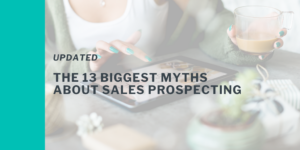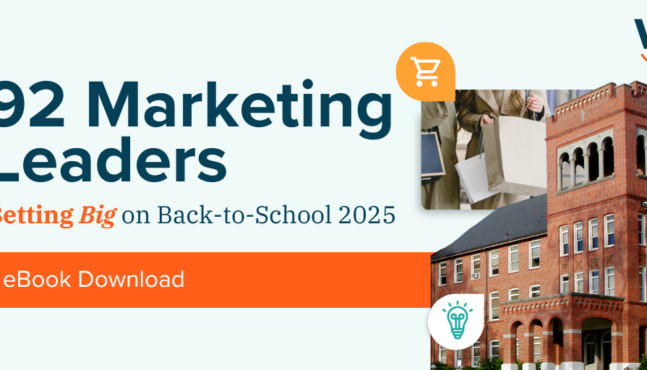
Updated: The 13 Biggest Myths About Sales Prospecting
Still holding onto the idea that all prospects are the same or that cold calling is a thing of the past? Time to let go of these sales myths and get honest about what truly works in today’s competitive landscape. In B2B sales, where relationships are often complex and decision-making cycles lengthy, it’s easy to fall into routine thinking that limits your effectiveness. These myths aren’t just outdated — they can actively hold you back from building a robust pipeline and securing meaningful connections with high-value clients.
With over 40% of sales professionals claiming that prospecting is the most challenging part of their role (according to Hubspot), it’s time to bust the myths and start seeing results. The Winmo team is here to tackle the 13 most common myths haunting the sales world and set the record straight:
1) Buyers don’t want to hear from you
Many buyers appreciate a helpful salesperson who reaches out at the right time with the right message, especially if it provides value to their current needs. In B2B sales, you often engage with busy professionals who value solutions that streamline their processes or resolve specific pain points. The key is empathizing with their challenges and delivering insights tailored to their industry or role. By offering actionable, well-researched information upfront, you’re not just making contact—you’re positioning yourself as a resource they’ll want to engage with again.
2) I’ve maxed out my network
Networks are dynamic, not static. Even if you think you’ve reached everyone, new connections, and opportunities constantly emerge as your clients’ businesses evolve. Stay engaged with your network, seeking ways to add value and solve emerging problems. Additionally, consider the power of mutual introductions—connecting clients or partners who can help each other reinforces your value within your network. In competitive B2B sectors, leveraging your network to create these connections can differentiate you as a strategic partner rather than just a salesperson.
3) Face-to-face networking is dead
While virtual meetings and digital communications are now commonplace, face-to-face interactions have a unique ability to build trust and rapport that’s hard to replicate online. In B2B, where long sales cycles and multiple stakeholders are typical, an in-person meeting can fast-track decision-making by establishing a stronger emotional connection. Use face-to-face interactions to understand client needs better, answer questions in real time, and create a more memorable impression. It’s often the personal touch that can make all the difference in a long-term business relationship.
4) Social media isn’t for serious networking
LinkedIn is a powerhouse for B2B networking, enabling meaningful engagement, strategic insights, and targeted outreach to decision-makers. You can establish credibility and warm up potential prospects before formal outreach by sharing valuable industry content, joining relevant conversations, and showcasing expertise. Social platforms are also effective for researching potential clients — understanding their challenges, interests, and recent activities, which can enhance your approach and make each touchpoint more relevant. If you’re not using social media to prospect, you’re leaving a critical channel untapped, potentially missing out on high-quality leads and connections that can fast-track your sales cycle.
5) Email is my only tool
Email alone won’t cut it — engagement rates are low, and relying solely on text-based outreach isn’t enough to keep your pipeline full. B2B buyers often respond well to a mix of personalized touchpoints across multiple channels. Incorporating video messages, LinkedIn outreach, and phone calls helps you stand out and engage more personally. For example, a quick 30-second video introduction or a LinkedIn message referencing industry news they’d find relevant can make a stronger impression than email alone. Diversifying your approach builds familiarity and shows you’re actively interested in helping, not just selling.
6) There’s no time to stay in touch with every contact
With tools like WinmoEdge and LinkedIn, staying updated on career changes and market shifts is easier than ever. B2B relationships are long-term investments, and maintaining even light contact can lead to new opportunities. When past clients take on new roles, they may be in positions where your solution is relevant again or may have insights on additional contacts within their new organization. Set reminders for quarterly check-ins, even if to congratulate them on a career move—this small effort can help you remain top of mind when new projects arise.
7) Cold calling is dead
Cold calling isn’t dead; it’s evolved to become more strategic. Persistence pays off, and many prospects still respond positively to calls, especially if you’re thoughtful, patient, and well-prepared. In B2B, this persistence often means a blend of research, follow-ups, and value-driven messaging to capture a prospect’s attention. Warm up your cold calls with prior touchpoints, such as an insightful LinkedIn comment or an email sharing relevant industry content. Each interaction builds familiarity, and by the time you call, the prospect may already know who you are and why you’re reaching out.
8) Prospects don’t read content
Generic content might go unread, but tailored insights crafted for a buyer’s unique business challenges make a difference. B2B prospects value content that provides actionable industry insights, making it a powerful tool for establishing credibility and securing follow-ups. To keep content relevant, consider a personalized approach—address their industry trends, share case studies that align with their challenges, or provide insights on how they can gain a competitive edge. This content isn’t just engaging; it positions you as a strategic partner rather than a transactional vendor.
9) Prospecting can wait until the end of the month
Regular, daily prospecting is critical to building a consistent, healthy pipeline. B2B sales cycles are typically longer, so dedicating time to prospecting daily allows you to nurture leads effectively and avoid end-of-month stress. By prospecting consistently, you can gauge which approaches work best, refine your messaging, and create a steady flow of new opportunities, making month-end goals more manageable and less frantic.
10) Share every product detail immediately
Don’t overwhelm your prospects by diving into product details from the start. Instead, listen first, understand their needs, and suggest solutions tailored to their pain. In B2B sales, it’s often more practical to position your solution as a collaborative partnership. Rather than running down a list of features, explain how your product can address their unique business challenges. This consultative approach helps prospects see you as an ally invested in their success, not just someone trying to close a deal.
11) You only need to worry about results
Sales is fundamentally about relationships. While hitting sales targets is crucial, focusing exclusively on results can harm trust and undermine long-term success. B2B buyers often look for solutions that contribute to their business’s growth over time, so emphasize how you can help them achieve their strategic goals. By putting their growth and needs first, you create a foundation for mutual success and position yourself as a partner they’ll want to work with for the long haul.
12) All prospects are the same
Every prospect is unique, with different needs, goals, and challenges. For B2B, this means taking the time to understand industry nuances, company size, business objectives, and even team dynamics. A one-size-fits-all approach won’t resonate—tailor your outreach to reflect what’s truly important to each prospect. This personalization shows that you’ve done your homework and are invested in helping them solve their specific problems, ultimately increasing the chances of building a solid client relationship.
13) The gatekeeper is your enemy
Quite the opposite — gatekeepers can be valuable allies in your sales journey. In B2B settings, gatekeepers often have insights into the decision-making process and can help you understand the best way to approach critical stakeholders. Rather than viewing them as obstacles, build rapport by acknowledging their role and treating them with respect. They can provide invaluable guidance on the prospect’s needs and priorities, often giving you the information you need to tailor your pitch or follow-up effectively.





